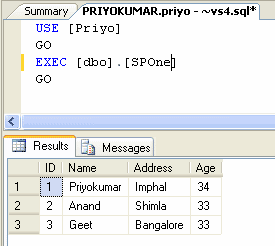
A stored procedure is a subroutine available to applications accessing a relational database system. Stored procedures (sometimes called a sproc or SP) are actually stored in the database.
Typical uses for stored procedures include data validation (integrated into the database) or access control mechanisms. Furthermore, stored procedures are used to consolidate and centralize logic that was originally implemented in applications. Large or complex processing that might require the execution of several SQL statements is moved into stored procedures and all applications call the procedures only.
Stored procedures are similar to user-defined functions (UDFs). The major difference is that UDFs can be used like any other expression within SQL statements, whereas stored procedures must be invoked using the
CALL statementStored procedures can return result sets, i.e. the results of a
SELECT statement. Such result sets can be processed using cursors by other stored procedures by associating a result set locator, or by applications. Stored procedures may also contain declared variables for processing data and cursors that allow it to loop through multiple rows in a table. The standard Structured Query Language provides IF, WHILE, LOOP, REPEAT, and CASE statements, and more. Stored procedures can receive variables, return results or modify variables and return them, depending on how and where the variable is declared.Implementation
A variety of advantages can be obtained through the use of stored procedures.
Pre-compilation of SQL statements
Stored procedures can run directly within the database engine. In a production system, this typically means that the procedures run entirely on a specialized database server, which has direct access to the data being accessed. The benefit here is that network communication costs can be avoided completely. This becomes particularly important for complex series of SQL statements.
Execution on a database server
Stored procedures allow for business logic to be embedded as an API in the database, which can simplify data management and reduce the need to encode the logic elsewhere in client programs. This may result in a lesser likelihood of data becoming corrupted through the use of faulty client programs. Thus, the database system can ensure data integrity and consistency with the help of stored procedures.
Some critics claim that databases should be for storing data only, and that business logic should only be implemented by writing a business layer of code, through which client applications should access the data. However, the use of stored procedures does not preclude the use of a business layer.
Security
In some systems, stored procedures can be used to control transaction management; in others, stored procedures run inside a transaction such that transactions are effectively transparent to them. Stored procedures can also be invoked from a database trigger or a condition handler. For example, a stored procedure may be triggered by an insert on a specific table, or update of a specific field in a table, and the code inside the stored procedure would be executed. Writing stored procedures as condition handlers also allow DBAs to track errors in the system with greater detail by using stored procedures to catch the errors and record some audit information in the database or an external resource like a file.
No comments:
Post a Comment